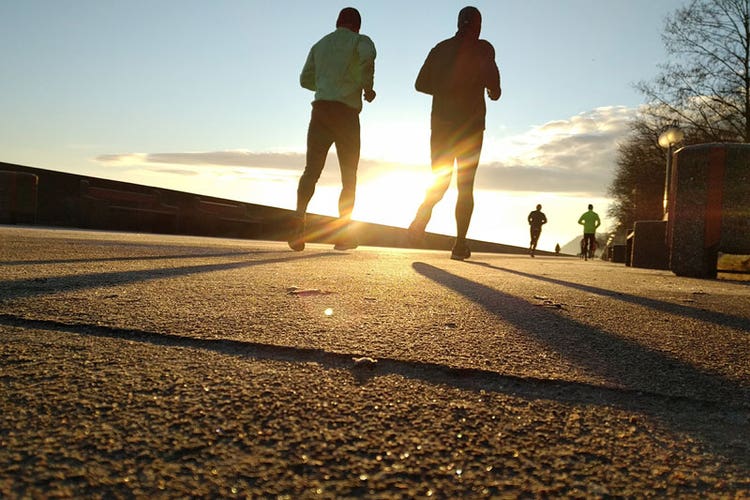How to Prepare for Indoor Running

Fall weather is coming (or here) and it may be time in reeling in running indoors. As Louis Pasteur said, “Luck favors the prepared,” and when it comes to hitting the treadmill in running indoors, luck or running injury-free may be possible if you prepare your body for indoor running. That’s because some things are not equal yet still effective: Treadmill running does not quite equate to running over ground outdoors.
Walking vs. running

First of all, walking on a treadmill is not so different from walking outdoors because running outdoors is more ballistic and has different mechanics. Regardless of speed, running is physiologically more strenuous.
For simplicity, running mechanics can be broken down into two components: a flight phase and a support phase. The flight phase is taking off and propelling yourself forward. This is the part of running that is ballistic, creating impact on the body. (There is no flight phase in walking.) The support phase is the component of running in which you’re on one leg while the other leg propels forward. In walking, your steps alternate between one leg and two legs.
Your running speed depends on your stride rate and stride length. The number of steps in one minute is your stride rate. Your optimal stride length is customized to your body— your height and length of your legs make it unique for you!
Treadmill vs. overground (outdoor) running—what’s the difference?

1. Ground reaction forces, the force the ground exerts on your body on impact may be more or less on a treadmill than outdoors. It all depends on your usual outdoor terrain. Running on concrete and asphalt may exert more ground reaction forces, but if you run on soft paved dirt, on grass or on a track, ground reaction forces may be less than a treadmill.
- If you’re used to running on softer terrain and with minimalist shoes or barefoot, make sure you allow your body to adapt to treadmill ground reaction forces before ramping up the mileage. Increasing your mileage a little at a time allows your body to adapt to the unaccustomed terrain.
2. Whether you feel it or not, the great outdoors calls for running against the air. Treadmill running has no resistance from air, so the calories burned with the same distance and the same speed is greater outdoors than on a treadmill.
- In mimicking the great outdoors, adding an incline of 3 to 4 percent grade helps in mimicking outdoor flat surface running.
3. A treadmill is a fixed environment. Because the terrain doesn’t change, a treadmill may be more stable, which may be terrific if you’re just getting back into running after an ankle sprain. You also may reproduce your workout depending on the speed of the belt and the gradient you select.
Your body adapts in the landing pattern, therefore your foot doesn’t have to “read” the terrain. Depending on your specific landing pattern, studies have shown that treadmill running causes your foot and ankle to invert (when the sole of your foot turns toward the inside of your body) or evert (when the sole of your foot turns toward the outside of your body) more than overground running.
Strengthen the intrinsic muscles of your foot:
- Place your foot flat on the ground, pushing all your toes flat to the ground while creating space in your arch area. Hold for 30 seconds.
- Dig your big toe to the ground, lifting the other four toes off the ground. Hold for 30 seconds.
- Dig your four little toes to the ground, lifting your big toe off the ground.
4. Running at faster speeds and steeper inclines on a treadmill may change your stride rate and stride length. If you alternate between running and walking or do interval running, acceleration and deceleration kinematics change. On a treadmill, you’re in a constrained environment, similar to a hamster running in its wheel. Your relative fast running speed has a reduction in degrees of freedom—or freedom to just run!
Treadmill running studies have shown there is an adjustment made by the body into a more constrained running pattern by shortening your natural stride length. This means adding more little steps at a suboptimal stride length and adding more ballistic impact and stress to your hip flexor, knee joint, Achilles tendon and plantar fascia.
- Lift one knee up, bringing it to a 90-degree angle. Perform slow counterclockwise and clockwise circles leading with your knee while keeping it at a 90-degree angle. Repeat for three to four cycles per leg.
- Be more dog and “wag your tail” by getting on all fours on the ground, rocking your hips side to side for about 30 seconds.
- Stretch your Achilles heel for 30 to 45 seconds after running by standing at the edge of a step and dropping your heel to the ground. Change the directions in which you drop your heel, covering right, left and center.
- “Walk the dog” by getting in a Down Dog yoga position. Spread your toes apart while alternating pushing your heels to the ground for about 30 seconds.
Treadmill running is a terrific way to keep you running in your fitness game … don’t let foul weather stop you! All you have to do is keep your body prepared for the changes with treadmill running.